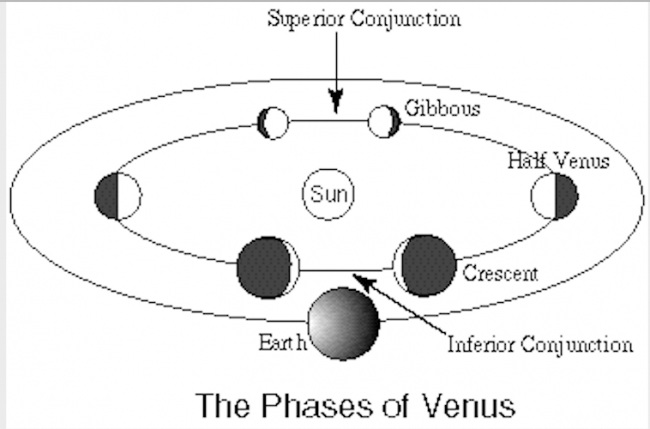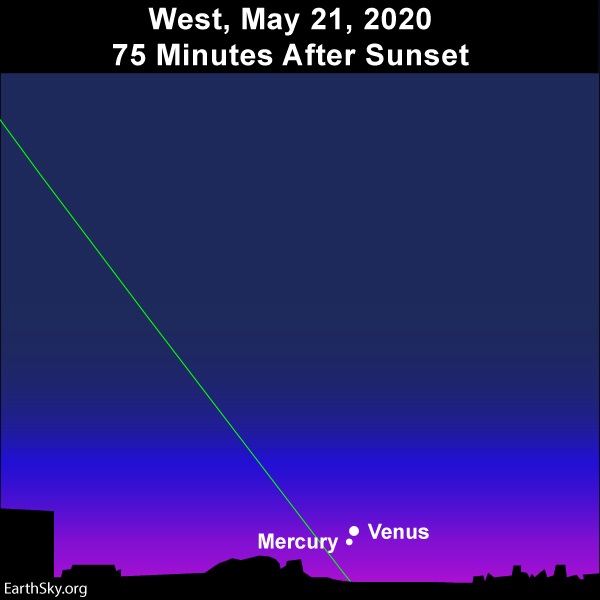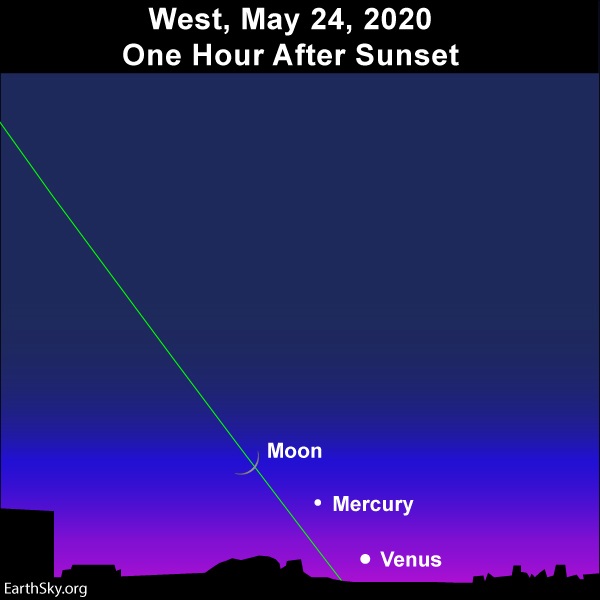Above: View at EarthSky Community Photos. | Dr Ski in the Philippines captured the image above of the very bright planet Venus on May 4, 2020, when the stars representing the Horns of Taurus the Bull were behind it. Now Taurus’ stars have likely sunk into the sunset, but Venus is still the brightest thing in the western twilight sky.
Watch for Venus. May is its last full month in the western twilight sky for the year 2020.
On June 3, Venus will swing between the Earth and sun in its orbit, reaching the point called inferior conjunction by astronomers. Afterwards it’ll transition over to the eastern sky before sunup. But what an exciting month for Venus this is! We’re seeing it sink closer to the western horizon day by day; when it’ll disappear into your sunset glare will depend how open your western horizon is, on the clarity of your sky, and on whether you’re using optical aid.
Those with telescopes will see that – as it gets closer to the sunset, preparing to go between us and the sun – more and more of the day side of Venus will turn away from our direction in space. Thus, throughout this month, we see Venus as a waning crescent.
The sun’s other inner planet – Mercury – will join the scene in the west after sunset beginning around mid-May.
All in all, a fascinating month to watch the western sky after sunset!
Although Venus plunges closer and closer to the sunset each day throughout May 2020, this world is still very easy to find in the west after sunset. People with exceptional eyesight sometimes see Venus in a daytime sky. Most of us can expect to see this bright beauty some 15 to 30 minutes after sundown. Venus stays out longer after dark at more northerly latitudes, however.
Have a telescope? This is by far the most exciting time to view Venus through the telescope. That’s because Venus in its faster orbit around the sun is rapidly catching up with our planet Earth. Therefore, Venus’ disk size is increasing while its phase is waning (shrinking). On May 5, 2020, Venus was 21% illuminated in sunshine. On May 12, it was 14% illuminated. On May 19, Venus will be only 8% illuminated. Three weeks later – May 26, 2020 – Venus will be 3% illuminated. All the while, the diameter of the visible disk of Venus will have increased by 80%.
All of this is happening because Venus is about to go between us and the sun.

Isn’t the diagram above cool? It shows why we see Venus as a crescent right now.
Here’s something else fun to think about. When Galileo (1564-1642) first saw the phases of Venus through the telescope, he came to the realization that Venus must orbit the sun instead of orbiting Earth. This observation countered the widely-held notion at the time that Venus orbits Earth.
But that’s not all that’s interesting here. Venus can also show you the sun’s other innermost planet, Mercury, this month. Beginning around mid-May, a line between Venus and the sunset point will enable you to find Mercury. Read more: After sunset, use Venus to find Mercury

Mercury officially entered the evening sky on May 4, 2020. It spends early May climbing away from the sunset glare. The innermost planet climbs high enough away from the sunset glare to become visible around mid-May. On or near May 21, 2020, watch for these two worlds to be within one degree of one another on the sky’s dome.
Then, several days after the Venus/Mercury conjunction, watch for the slender waxing lunar crescent to join up with Mercury and Venus at dusk. Think photo opportunity!
Afterwards, Venus will continue to fall toward the sunset while Mercury will soar upward. Mercury will reach its greatest eastern elongation (greatest angular distance) from the setting sun on June 4, 2020.

Bottom line: Before Venus officially transits to the morning sky on June 3, 2020, it will be exceedingly fun to watch, with or without a telescope. Find an unobstructed horizon in the direction of sunset. With some luck and clear skies, you might be able to view Venus in the western evening dusk until the month’s end.











